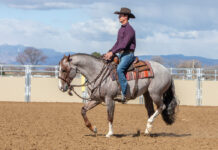
- Even if you don’t own a horse trailer, your horse needs to know how to load easily in case of an emergency.
- If possible, carry two spare tires for your horse trailer.
- ST (special trailer) tires, not passenger car or light truck tires, should be used. An ST tire has about 10 percent more load capacity than an equivalent LT tire and nearly 40 percent more than a P tire when each is filled to its maximum PSI rating.
- Check to ensure that your ball hitch is the right size for your trailer.
- If you feed hay in transit, make sure it’s not dusty.
- If it’s safe to do so, leave your horse untied during transit so that he can lower his head, which studies have shown is healthier for his respiratory system.
- Have a qualified mechanic service your trailer at least once a year—checking lights, brakes, suspension and floor.
- The wheel bearings will also need servicing every 12,000 miles or once a year, whichever comes first.
- Give your trailer a thorough once-over the day before a trip or show. Pay close attention to your tire inflation and sidewall wear.
- Before every trip, check truck tire pressure, along with the oil and fluids.
- Always outfit your horse in shipping boots before loading up. A head bumper is also advised.
- Double check that your hitch, brakes and lights are connected correctly. Cross your safety chains for extra security.
- Chock your wheels whenever your trailer is parked.
- Once your horse is loaded, physically handle each latch to ensure that all doors are secure before you drive off.
- On the open road, allow plenty of distance between you and the cars in front of you, and remember that it takes longer to stop when towing a trailer.
- It’s not advisable to unload your horses on the side of a road.
- Never unhitch your trailer with your horses still in it.
- Carry a trailer jack.
- If you get a flat tire, try to drive slowly to the nearest service station when it’s safe to do so.
- Research roadside assistance programs to make sure your rig and horses will be taken care of in the event of a breakdown. (USRider is one plan designed specifically for equestrian motorists.)
- Just because your tow vehicle can pull your trailer doesn’t mean it should: Check its ratings to ensure it can safely handle the task.
- Carry an equine first-aid kit in your trailer.
- Other handy items to have in case of an emergency are extra halters and lead ropes, a supply of water for your horse and extra hay/feed.
- If you have trouble hitching solo, use one of the many handy devices that help line up ball to hitch.
- Only haul the number of horses your trailer is designed to handle.
- Make sure drop down windows are screened so that your horse can’t get his head out, and road debris can’t get in.
- If you’re traveling a long distance, stop every four hours to give your equine road warrior a break; let him drop his head to the ground if he’s been tied; offer plenty of fresh water and hay.
- If you’re hauling your horse by himself in a two-horse straight-load trailer, always put him on the left side. It helps balance the trailer on crowned roads (roads that slope to the shoulder).
- Always clean out your trailer after each use to increase its life span and keep your horse’s environment sanitary.
- Check ramp springs for rust and wear. A spring that breaks as a horse puts his weight on it is very dangerous.
This article originally appeared in the April 2006 issue of Horse Illustrated magazine. Click here to subscribe!






Before loading check for bees nests.